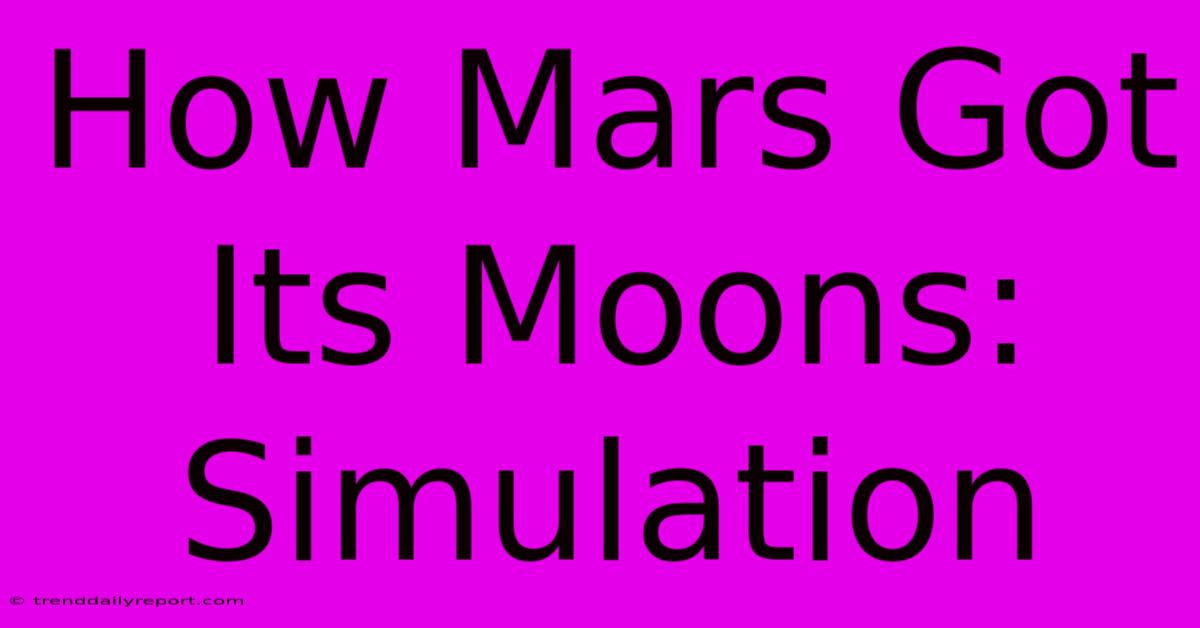How Mars Got Its Moons: Simulation

Discover more detailed and exciting information on our website. Click the link below to start your adventure: Visit Best Website How Mars Got Its Moons: Simulation. Don't miss out!
Table of Contents
How Mars Got Its Moons: A Simulation Story (and Some Seriously Weird Science)
Hey everyone! So, I've always been fascinated by space – like, seriously obsessed. I mean, who isn't? But lately, I've been totally geeking out over Mars's moons, Phobos and Deimos. They're tiny, oddly shaped, and their origins have been a total mystery… until recently! I dove headfirst into some simulations, and let me tell you, it's been a wild ride.
I'll admit, my first attempt at understanding this whole thing was a total disaster. I tried to just read scientific papers, you know, the dense, jargon-filled kind? Ugh. My brain felt like it was turning into a black hole, sucking in all my understanding and spitting out confusion. I needed something visual. Something I could see.
<h3>My First Simulation Fail (and What I Learned)</h3>
So, I started playing around with some free online planet formation simulators. I thought, "How hard can it be?" Turns out, really hard. My first few simulations resulted in…well, nothing resembling Mars's moons. I ended up with planets colliding and forming bizarre, misshapen blobs – nothing close to the potato-like shapes of Phobos and Deimos. It was super frustrating. I was ready to give up and just stick to watching documentaries.
Then, I found this amazing simulation created by a team at the Southwest Research Institute. This simulation was different. They used supercomputers to model the chaotic early solar system, focusing on the giant impacts that shaped the planets.
<h3>The Giant Impact Hypothesis: A Simulation Success!</h3>
This is where things got really interesting. The simulation showed that a massive object, likely an asteroid or protoplanet, smashed into Mars billions of years ago. This collision didn't just create craters; it flung huge amounts of Martian debris into orbit. Over time, this debris clumped together, eventually forming Phobos and Deimos.
Think of it like this: imagine throwing a handful of clay into the air. Some of it sticks together, creating smaller clumps. That's kind of what happened, only on a much, much larger scale. The simulation even showed the different orbital characteristics of Phobos and Deimos accurately - how Phobos is slowly spiralling inwards towards Mars, and Deimos is drifting further away. Mind blown!
<h3>Key Takeaways from the Simulations (and Some Cool Facts)</h3>
- Giant impacts are a BIG deal: They're not just about creating craters; they can shape planetary systems entirely. It completely changed my perspective on planetary formation. It's not a slow, gradual process; it can be incredibly violent and chaotic.
- Simulations are powerful tools: They allow scientists to test theories and visualize processes that we can't directly observe. It's like having a time machine, albeit a virtual one!
- Phobos and Deimos are remnants of a catastrophic event: They're more than just "moons"; they're tangible pieces of Mars's violent past. Think about that next time you look up at the night sky!
I’m still learning, of course. There are always new papers and simulations to explore, and frankly, there's still plenty we don't know about the early solar system. But seeing these simulations work and understanding the process behind how Mars got its moons is incredibly rewarding. It's a testament to human curiosity and our ability to unravel the mysteries of the universe, one simulation at a time. So grab your own virtual telescope and go explore! You might just discover something amazing.
Keywords: Mars moons, Phobos, Deimos, planetary formation, giant impact, simulation, asteroid, protoplanet, solar system, orbital characteristics, Southwest Research Institute.

Thank you for visiting our website wich cover about How Mars Got Its Moons: Simulation. We hope the information provided has been useful to you. Feel free to contact us if you have any questions or need further assistance. See you next time and dont miss to bookmark.
Featured Posts
-
Ucl Visit Havant Mp Mak
Nov 27, 2024
-
Watch Bayern Vs Psg Match November 26
Nov 27, 2024
-
Upgrade Steam Deck 2 Intel Ultra 2
Nov 27, 2024
-
Barcelona Vs Brest Champions League Live
Nov 27, 2024
-
Army Recruiting La And Atlanta
Nov 27, 2024
